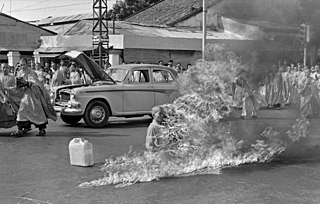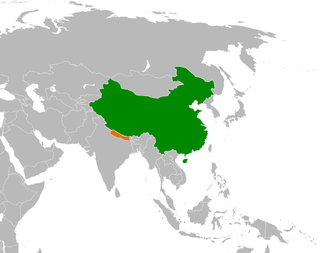Related Research Articles

Tibet or Greater Tibet is a region in the central part of East Asia, covering much of the Tibetan Plateau and spanning about 2,500,000 km2 (970,000 sq mi). It is the homeland of the Tibetan people. Also resident on the plateau are some other ethnic groups such as the Monpa, Tamang, Qiang, Sherpa and Lhoba peoples and, since the 20th century, considerable numbers of Han Chinese and Hui settlers. Since the annexation of Tibet by the People's Republic of China in 1951, the entire plateau has been under the administration of the People's Republic of China. Tibet is divided administratively into the Tibet Autonomous Region, and parts of the Qinghai and Sichuan provinces. Tibet is also constitutionally claimed by the Republic of China as the Tibet Area since 1912.

The Tibetan independence movement is the political movement advocating for the reversal of the 1950 annexation of Tibet by the People's Republic of China, and the separation and independence of Greater Tibet from China.

Self-immolation is the act of setting oneself on fire. It is mostly done for political or religious reasons, often as a form of protest or in acts of martyrdom. Due to its disturbing and violent nature, it is considered one of the most extreme methods of protest.

The Jokhang, also known as the Qoikang Monastery, Jokang, Jokhang Temple, Jokhang Monastery and Zuglagkang, is a Buddhist temple in Barkhor Square in Lhasa, the capital city of Tibet Autonomous Region of China. Tibetans, in general, consider this temple as the most sacred and important temple in Tibet. The temple is currently maintained by the Gelug school, but they accept worshipers from all sects of Buddhism. The temple's architectural style is a mixture of Indian vihara design, Tibetan and Nepalese design.
Free Tibet (FT) is a non-profit, non-governmental organisation, founded in 1987 and based in London, England. According to their mission statement, Free Tibet advocates for "a free Tibet in which Tibetans are able to determine their own future and the human rights of all are respected."

Students For a Free Tibet (SFT) is a global grassroots network of students and activists working in solidarity with the Tibetan people for human rights and freedom. The group uses education, advocacy, and nonviolent direct action with the goal of achieving Tibetan independence. SFT advocates self-determination for Tibet because of Tibet's historical status as well as opposing the Chinese government's violation of the Tibetan people's human rights, cultural heritage, environment, language and religion.
The Tibet national football team is a football team that represents the cultural region of Tibet in non-FIFA international tournaments, and is organized by the Tibetan National Football Association (TNFA), an organization of exiled Tibetans.

The 2008 Summer Olympics torch relay was run from March 24 until August 8, 2008, prior to the 2008 Summer Olympics, with the theme of "one world, one dream". Plans for the relay were announced on April 26, 2007, in Beijing, China. The relay, also called by the organizers as the "Journey of Harmony", lasted 129 days and carried the torch 137,000 km (85,000 mi) – the longest distance of any Olympic torch relay since the tradition was started ahead of the 1936 Summer Olympics.

The history of Tibet from 1950 to the present includes the Chinese invasion of Tibet in 1950, and the Battle of Chamdo. Before then, Tibet had been a de facto independent nation. In 1951, Tibetan representatives in Beijing signed the Seventeen Point Agreement under duress, which affirmed China's sovereignty over Tibet while it simultaneously supported the establishment of an autonomous administration which would be led by Tibet's spiritual leader, and then-political leader, the 14th Dalai Lama. During the 1959 Tibetan uprising, when Tibetans attempted to prevent his possible assassination, the Dalai Lama escaped from Tibet and moved to northern India, where he established the Central Tibetan Administration, which rescinded the Seventeen Point Agreement. The majority of Tibet's land mass, including all of U-Tsang and areas of Kham and Amdo, was officially established as the Tibet Autonomous Region, within China, in 1965.

The 1959 Tibetan uprising began on 10 March 1959, when a revolt erupted in Lhasa, the capital of Tibet, which had been under the effective control of the People's Republic of China (PRC) since the Seventeen Point Agreement was reached in 1951. The initial uprising occurred amid general Chinese-Tibetan tensions and a context of confusion, because Tibetan protesters feared that the Chinese government might arrest the 14th Dalai Lama. The protests were also fueled by anti-Chinese sentiment and separatism. At first, the uprising mostly consisted of peaceful protests, but clashes quickly erupted and the Chinese People's Liberation Army (PLA) eventually used force to quell the protests, some of the protesters had captured arms. The last stages of the uprising included heavy fighting, with high civilian and military losses. The 14th Dalai Lama escaped from Lhasa, while the city was fully retaken by Chinese security forces on 23 March 1959. Thousands of Tibetans were killed during the 1959 uprising, but the exact number of deaths is disputed.

The 2008 Tibetan unrest, also referred to as the 2008 Tibetan uprising in Tibetan media, was a series of protests and demonstrations over the Chinese government's treatment and persecution of Tibetans. Protests in Lhasa, the capital of Tibet, by monks and nuns on 10 March have been viewed as the start of the demonstrations. Numerous protests and demonstrations were held to commemorate the 49th anniversary of the 1959 Tibetan Uprising Day, when the 14th Dalai Lama escaped from Tibet. The protests and demonstrations spread spontaneously to a number of monasteries and throughout the Tibetan plateau, including into counties located outside the designated Tibet Autonomous Region. The arrest of monks at Labrang Monastery increased the tension of the situation. Violence began when Chinese police and People's Liberation Army units used force on non-violent protests by monks and nuns, and spread when protesting Tibetans later clashed with security forces. Clashes also occurred between Tibetans and Chinese Han and Hui residents, resulting in Han and Hui stores and buildings being destroyed and numerous Chinese civilians being injured or killed.

Tibetan Uprising Day, observed on March 10, commemorates the 1959 Tibetan uprising which began on March 10, 1959, and the Women's Uprising Day of March 12, 1959, involving thousands of women, against the presence of the People's Republic of China in Tibet.
The Tibetan Youth Congress (TYC) is an international non-governmental organization that advocates the independence of Tibet from China. With around 30,000 members in the Tibetan diaspora, it is the largest of the pro-independence organizations of Tibetan exiles with 87 branches in 10 countries listed on the organisation's website. The current president of the Tibetan Youth Congress is Gonpo Dhundup.

The bilateral relation between Nepal and China is defined by the Sino-Nepalese Treaty of Peace and Friendship signed on April 28, 1960, by the two countries. Though initially unenthusiastic, Nepal has been of late making efforts to increase trade and connectivity with China. Relations between Nepal and China got a boost when both countries solved all border disputes along the China–Nepal border by signing the Sino-Nepal boundary agreement on March 21, 1960, making Nepal the first neighboring country of China to agree to and ratify a border treaty with China. The government of both Nepal and China ratified the border agreement treaty on October 5, 1961. From 1975 onward, Nepal has maintained a policy of balancing the competing influence of China and Nepal's southern neighbor India, the only two neighbors of the Himalayan country after the accession of the Kingdom of Sikkim into India in 1975.
The 1987–1989 Tibetan unrest was a series of protests and demonstrations that called for Tibetan independence. These protests took place between September 1987 and March 1989 in the Tibet Autonomous Region, in the Tibetan regions of Sichuan, and Qinghai, as well as the Tibetan prefectures in Yunnan and Gansu. Protests began shortly after the Dalai Lama, the religious and temporal leader of Tibet exiled in India since the 1959 Tibetan unrest, proposed a Five Point Peace Plan regarding the “status of Tibet” on September 21, 1987, which was subsequently rejected by the Chinese government. The Plan advocated for greater respect and autonomy of the Tibetan people, and claimed that “Tibet was a fully independent state when the People’s Liberation Army invaded the country in 1949-50.” China rejected the idea of Tibetans as an invaded people, stating that “Tibet is an inalienable part of Chinese territory” and has been for hundreds of years. The Tibetan sovereignty debate is longstanding, and the Tibetan assertion that they are a separate and unique people invaded by China has become a central argument for their independence.
The 2008 Tibetan unrest was a series of protests and demonstrations met by excessive force, focused on the persecution of Tibetans, in the buildup to the 2008 Summer Olympics in Beijing. There was a mixture of outrage and understanding from leading figures abroad.

Human rights in Tibet are a contentious issue. Reported abuses of human rights in Tibet include restricted freedom of religion, belief, and association; arbitrary arrest; maltreatment in custody, including torture; and forced abortion and sterilization. The status of religion, mainly as it relates to figures who are both religious and political, such as the exile of the 14th Dalai Lama, is a regular object of criticism. Additionally, freedom of the press in China is absent, with Tibet's media tightly controlled by the Chinese leadership, making it difficult to accurately determine the scope of human rights abuses.

Protests and uprisings in Tibet against the government of the People's Republic of China have occurred since 1950, and include the 1959 uprising, the 2008 uprising, and the subsequent self-immolation protests.

As of May 2022, 160 monks, nuns, and ordinary people have self-immolated in Tibet since 27 February 2009, when Tapey, a young monk from Kirti Monastery, set himself on fire in the marketplace in Ngawa City, Ngawa County, Sichuan. According to the International Campaign for Tibet (ICT), "Chinese police have beaten, shot, isolated, and disappeared self-immolators who survived."
References
- ↑ Quickfire protest catches police off guard. Mumbai Newsline [ dead link ]
- ↑ "Tibet activists protest against China's influence onto Nepal". Phayul.com. Archived from the original on 7 September 2012. Retrieved 31 May 2014.
- TNFA, team 2007
- (in French) Shaolin Soccer Foot au Tibet, team 2008
